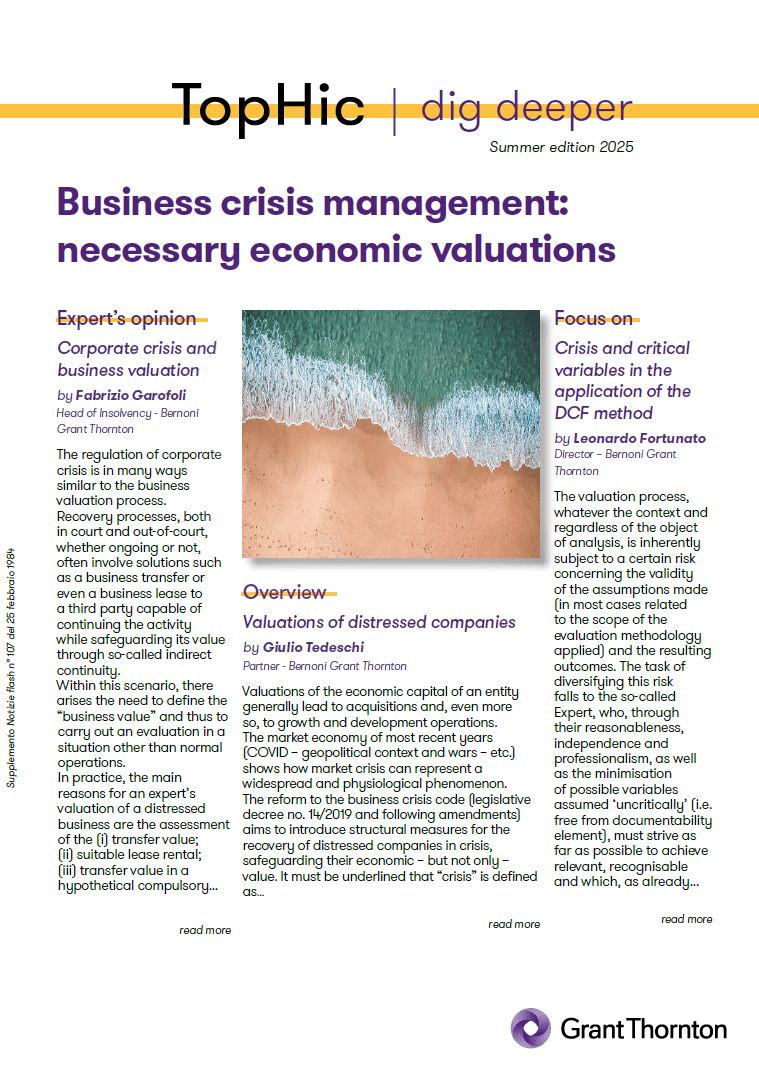
Valuations of the economic capital of an entity generally lead to acquisitions and, even more so, to growth and development operations.
The market economy of most recent years (COVID – geopolitical context and wars – etc.) shows how market crisis can represent a widespread and physiological phenomenon. The reform to the business crisis code (legislative decree no. 14/2019 and following amendments) aims to introduce structural measures for the recovery of distressed companies in crisis, safeguarding their economic – but not only – value.
It must be underlined that “crisis” is defined as “the debtor's situation that makes insolvency likely and that shows itself as the inadequacy of prospective cash flows to meet obligations over the next 12 months” (art. 2, para. 1, lett. a) of the business crisis code). On the other hand, “insolvency” means “the debtor’s situation that shows itself as defaults or other external factors, which demonstrate that the debtor is no longer able to regularly meet their obligations” (art. 2, para. 1, lett. b) of the business crisis code[1].
In brief, both definitions above, according to a regulatory interpretation, indicate that the “crisis” pathologically precedes the occurrence of “insolvency”. Therefore, it is possible to intervene and solve the crisis situation to avoid insolvency, which, instead, is irrevocable (and leads to compulsory winding up). Identifying the most suitable measures for safeguarding a distressed company with a view to restructuring and continuity shall be based on regulatory instruments that require the performance of the valuations examined in this article.
In other words, valuations are also crucial within business crisis to support the regulatory instruments introduced to overcome the crisis and rebalance the company's economic and financial position.
The most qualified authors analysed this aspect and pointed out that the consequences of the business crisis can be more or less serious depending on how quickly it is identified and how it is managed.[2]
Therefore, valuations are useful not only as technical instrument to support the recovery measures provided under the business crisis code, but also as a tool for a conscious management, since an informed valuation of the company in crisis can represent a crucial diagnosis and management tool.
Valuations can help not only identifying the seriousness of a crisis, but also understanding its causes: in fact, valuations within the crisis management phase should be aimed at assessing the actual value of corporate assets, which is the starting point for crisis resolution.
A valuator, besides identifying the particular aim of a valuation, should be independent from self-interests, as well as from the analysis of restructuring plans that may be subject to distortions, but which represent the crucial starting point to perform valuations.
This issue of TopHic includes the expert’s opinion (by Fabrizio Garofoli), which will analyse the cases in which the Business crisis code expressly requires the involvement of an expert for the performance of valuations required under the many different procedures, as well as an article (by Leonardo Fortunato) analysing the possible valuation methods to be adopted within the specific context of companies in financial crisis – taking into account critical aspects, perspectives, and practical applicability of the methods.
In conclusion, we would like to point out some aspects that involve the professionals dedicated to such area. First of all, what are the steps required to perform a valuation of a distressed company? The common practice identifies at least four phases: (i) the crisis analysis, (ii) the structure of the valuation system, (iii) the analysis of the restructuring plan, (iv) the valuation methods to be selected and applied.[3] With particular reference to the last phase, it should be pointed out that a valuator must first consider the risks associated with the various value configurations that are the subject of the valuation. In fact, a distressed company generally requires an operating restructuring and, therefore, can be more or less intense and risky. The approach to valuation must identify the steps that the company intends to take to realize its restructuring, hence the risk of the plan and its failure risk.
The risk of the plan is in all value configurations adopted, which are based on a continuity perspective (recoverable value).
The plan failure risk, on the other hand, is only in some value configurations, which are based on a “mixed” perspective, i.e., providing either the possible realization of the plan, or the possible liquidation of the company.
All these aspects must be carefully considered, as the models and methodologies that characterise most valuations are not automatically applicable to this type of valuation. In fact, it is more difficult to find comparisons with market values or comparable assets, as well as useful elements for estimating a replacement cost.
It is a professional activity of an interdisciplinary nature that requires a high degree of attention.
[1] The norm invites to a purely financial interpretation: the inadequacy of financial flows or the impossibility to pay one’s obligations. However, the well-established assertion that a financial crisis is objectively a consequence of an economic crisis cannot be ignored; as such, the latter precedes a financial crisis.
[2] See M. Bini “Le valutazioni delle aziende in crisi” (Valuation of distressed companies) EGEA 2025.
[3] OIV – Organismo Italiano di valutazione (Italian valuation organisation) - Discussion paper n.1/25: “La valutazione delle aziende in crisi” (Valuation of distressed companies)
